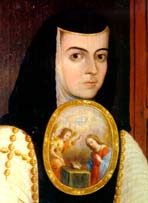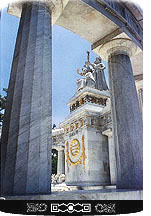March 20-24
 Click
here to link to a great site about Sor Juana
Click
here to link to a great site about Sor JuanaLecture Outline:
A. Women and Religious Life
1. "Islands (?) of Women" :The Convent as Microcosm of Colonial
Society
2. Sor Juana Inés de la Cruz: Poetry and the letter to
the Archbishop of Puebla
3. Beatas : The Famous Sta. Rosa de Lima, and the Not-so-Famous
Mexican Beata, María
B. The Inquisition as Arbiter of Colonial Religion
C. Cofradías and Black and Mulatto Brotherhoods
D. Whose Religious Symbols Are They?: The Cases of Santiago the
Mountain God and The Virgin of Guadalupe
Key Terms:
| Irmandade
Cofradía Beata |
Illapa
Juan Diego Tonontzin |
Santiago
Black Veil Holy Office of the Inquisition |
Luís Martin, "Islands of Women" from Daughters of the Conquistadors; pp.172-200.
William B. Taylor, "The Virgin of Guadalupe in New Spain: An inquiry in thesocial history of marian devotion." from American Ethonologist (1987): pp. 9-33.
Sor Juana’s Letter from Colonial Spanish America: A Documentary History (1997)
Questions for Consideration:
1. How were cofradías and convents instruments of colonial hegemony? What colonial Spanish aims did these institutions help fulfill, and who benefitted from them? How were cofradías and convents used as "resistance," escape from or protection against colonial aims by the people who entered or participated in them?
2. Consider the popularity and character of the seventeenth- and eighteenth-century cases of Santiago and the Virgin of Guadalupe. Include a) who participated in these movements or in veneration, b) the degree of syncretism or the problem of the concept of syncretism c) the Church's reaction to the movements.
 Office of the Inquisition, Mexico City
Office of the Inquisition, Mexico City